The Impact of a Lack of Government Strategies for Sustainable Water Management and Land Use Planning on the Hydrology of Water Bodies: Lessons Learned from the Disappearance of the Aculeo Lagoon in Central Chile
Abstract
1. Introduction
2. Materials and Methods
2.1. Case Study
2.2. Data Gathering and Methods
3. Results
4. Discussion
4.1. Land Use and Socio-Economic Changes of the Aculeo Watershed
4.1.1. The Agrarian Reform Triggering Land and Water Use Transformations
4.1.2. Evolution of Large-Scale Agriculture in the Watershed
4.2. Regional Climate Variability in the Southern Westerly Wind Belt and Paleoclimatology of Aculeo
4.3. Understanding Precipitation Recycling Effects in Aculeo
4.4. Climate Records Used for Water Balance Simulations in Aculeo
4.5. Anthropogenic Diversions and the Lagoon’s Water Balance
4.6. A Long-Term Natural Relationship between Precipitation and Water Levels
4.7. Increased Water Demands and Allocation of Water Rights
4.8. Regional Aquifers and Groundwater Storage Volumes
5. Conclusions and Recommendations
Author Contributions
Funding
Institutional Review Board Statement
Informed Consent Statement
Data Availability Statement
Acknowledgments
Conflicts of Interest
Appendix A
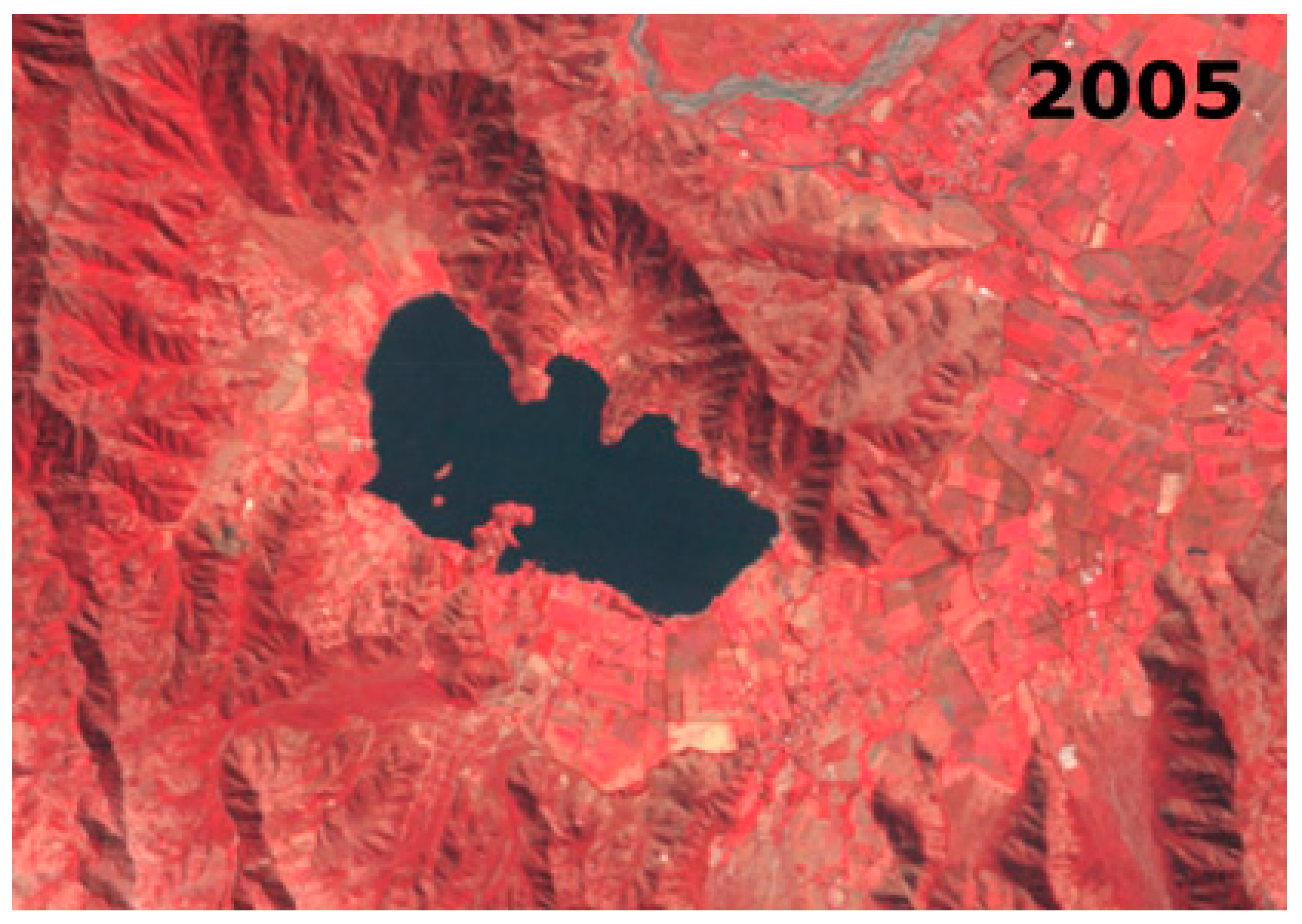
Appendix B

Appendix C

Appendix D

Appendix E

Appendix F
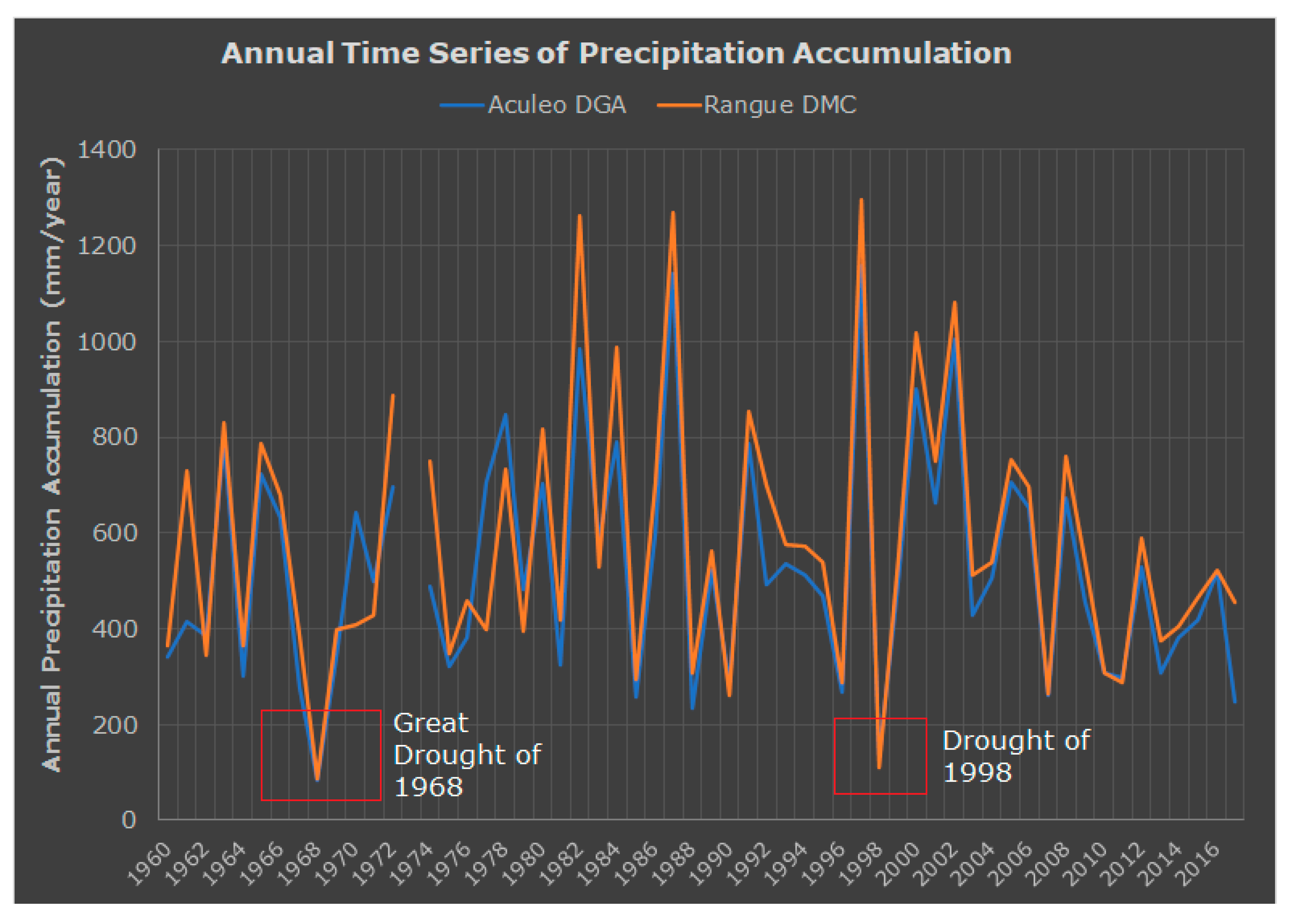
Appendix G. Other Relevant Details That Should Be Corrected by Barría et al., 2021
References
- Hamidi, S.M.; Fürst, C.; Nazmfar, H.; Rezayan, A.; Yazdani, M.H. A Future Study of an Environment Driving Force (EDR): The Impacts of Urmia Lake Water-Level Fluctuations on Human Settlements. Sustainability 2021, 13, 11495. [Google Scholar] [CrossRef]
- Maleki, R.; Nooripoor, M.; Azadi, H.; Lebailly, P. Vulnerability Assessment of Rural Households to Urmia Lake Drying (the Case of Shabestar Region). Sustainability 2018, 10, 1862. [Google Scholar] [CrossRef]
- Tussupova, K.; Anchita; Hjorth, P.; Moravej, M. Drying Lakes: A Review on the Applied Restoration Strategies and Health Conditions in Contiguous Areas. Water 2020, 12, 749. [Google Scholar] [CrossRef]
- Boisier, J.P.; Rondanelli, R.; Garreaud, R.D.; Muñoz, F. Anthropogenic and natural contributions to the Southeast Pacific precipitation decline and recent megadrought in central Chile. Geophys. Res. Lett. 2016, 43, 413–421. [Google Scholar] [CrossRef]
- Saneha, A.H.; Castillo, G.; Thiers, R. Estudio Limnológico de la Laguna de Aeu1eo; Publicación I-44; Facultad de Ciencias Físicas y Matemáticas, Departamento de Obras Civiles, Universidad de Chile: Santiago, Chile, 1977; 25p. [Google Scholar]
- Balbontin, R.; Labra, P.; Valdes, J. Lagunas, Embalses y Tranques en Relación a la Región Metropolitana; Departamento de Urbanismo, Universidad de Chile: Seminario, Santiago, Chile, 1982; 145p. [Google Scholar]
- Cabrera, S.; Montecino, V. Eutrophy in lake Aculeo, Chile. Plant Soil 1982, 67, 377–387. [Google Scholar] [CrossRef]
- Nasi, C.; Thiele, R. Estratigrafía del Jurls1co y Cretácico de la Cord1llera de la Costa, al sur del río Maipo, entre Melipilla y Laguna de Aculeo (Chile Central). Rev. Geológica Chile 1982, 16, 81–99. [Google Scholar]
- Jenny, B.; Valero-Garcés, B.L.; Villa-Martınez, R.; Urrutia, R.; Geyh, M.; Veit, H. Early to mid-Holocene aridity in central Chile and the southern westerlies: The Laguna Aculeo record (34 S). Quat. Res. 2002, 58, 160–170. [Google Scholar] [CrossRef]
- Jenny, B.; Wilhelm, D.; Valero-Garcés, B. The Southern Westerlies in Central Chile: Holocene precipitation estimates based on a water balance model for Laguna Aculeo (33 50′S). Clim. Dyn. 2003, 20, 269–280. [Google Scholar] [CrossRef]
- Villa-Martínez, R.; Villagrán, C.; Jenny, B. The last 7500 cal yr BP of westerly rainfall in Central Chile inferred from a high-resolution pollen record from Laguna Aculeo (34 S). Quat. Res. 2003, 60, 284–293. [Google Scholar] [CrossRef]
- Razik, S.; Chiessi, C.M.; Romero, O.E.; von Dobeneck, T. Interaction of the South American monsoon system and the southern westerly wind belt during the last 14 kyr. Palaeogeogr. Palaeoclimatol. Palaeoecol. 2013, 374, 28–40. [Google Scholar] [CrossRef]
- Silva, P.C. Evaluación del Sistema Socio-Ecológico de la Cuenca de Aculeo en la Comuna de Paine, Región Metropolitana. Master’s Thesis, Facultad de Ciencias Forestales y Conservación de la Naturaleza, Universidad de Chile, Santiago, Chile, 2017; 201p. [Google Scholar]
- Alaniz, A.; Carvajal, M.; Núñez-Hidalgo, I.; Vergara, P. Chronicle of an Environmetal Disaster: Aculeo Lake, the Collapse of the Largest Natural Freshwater Ecosystem in Central Chile. Environ. Conserv. 2019, 46, 201–204. [Google Scholar] [CrossRef]
- Venegas-Quiñones, H.L.; Thomasson, M.; Garcia-Chevesich, P. Water Scarcity or Drought? The Cause and Solution for The Lack of Water in Laguna de Aculeo. Water Conserv. Manag. 2020, 4, 42–50. [Google Scholar] [CrossRef]
- Valdés-Pineda, R.; García-Chevesich, P.; Valdés, J.B.; Pizarro-Tapia, R. The First Drying Lake in Chile: Causes and Recovery Options. Water 2020, 12, 290. [Google Scholar] [CrossRef]
- Barría, P.; Chadwick, C.; Ocampo-Melgar, A.; Galleguillos MGarreaud, R.; Díaz-Vasconcellos RPoblete, D.; Rubio-Álvarez, E.; Poblete-Caballero, D. Water management or megadrought: What caused the Chilean Aculeo Lake drying? Reg. Environ. Change 2021, 21, 1–5. [Google Scholar] [CrossRef]
- Garreaud, R.D.; Alvarez-Garreton, C.; Barichivich, J.; Boisier, J.P.; Christie, D.; Galleguillos, M.; LeQuesne, C.; McPhee, J.; Zambrano-Bigiarini, M. The 2010–2015 megadrought in central Chile: Impacts on regional hydroclimate and vegetation. Hydrol. Earth Syst. Sci. 2017, 21, 6307–6327. [Google Scholar] [CrossRef]
- Hargreaves, G.H.; Allen, R.G. History and evaluation of Hargreaves evapotranspiration equation. J. Irrig. Drain. Eng. 2003, 129, 53–63. [Google Scholar] [CrossRef]
- Rivas, C. Análisis Multicriterio para la Recuperación de la Laguna de Aculeo. Master’s Thesis, Universidad de Chile. Facultad de Ciencias Forestales y Conservación de la Naturaleza, Santiago, Chile, 2019; 232p. [Google Scholar]
- Sáez Rosenkranz, I. Movimiento Populares, Siglos XIX y XX. “Soy Campesino y soy Cantor”, la Fiesta de la Cruz de Mayo, un Espacio de Sociabilidad y Conformación de Identidad Campesina, Aculeo 1960–2005. B. Sc. Thesis, Facultad de Filosofía y Humanidades, Universidad de Chile, Santiago, Chile, 2005; 79p. [Google Scholar]
- Valencia García, C. Transformaciones Socio-Territoriales Derivadas de la Urbanización del Suelo, Laguna de Aculeo, Paine, Región Metropolitana. B. Sc. Thesis, Facultad de Geografía, Universidad Academia de Humanismo Cristiano, Santiago, Chile, 2018; 224p. [Google Scholar]
- Kay, C. Agrarian reform and the class struggle in Chile. Lat. Am. Perspect. 1978, 5, 117–142. [Google Scholar] [CrossRef]
- Jarvis, L.S. The unraveling of Chile’s agrarian reform, 1973–1986. In Searching for Agrarian Reform in Latin America; Thiesenhusen, W.C., Ed.; Unwin Hyman: London, UK, 1989; pp. 240–275. [Google Scholar]
- Armijo, G.; Caviedes, H. Vicisitudes y Cambios en el Mundo rural Chileno: La Última Modernización Agraria ¿La Gran Solución de fin de Siglo? Anales de la Universidad de Chile: Santiago, Chile, 1997; No. 5. [Google Scholar]
- Reyes-Paecke, S.; Gironás, J.; Melo, O.; Vicuña, S.; Herrera, J. Irrigation of green spaces and residential gardens in a Mediterranean metropolis: Gaps and opportunities for climate change adaptation. Landsc. Urban Plan. 2019, 182, 34–43. [Google Scholar] [CrossRef]
- Balogh, J.C.; Watson, J.R. Role and Conservation of Water Resources. In Golf Course Management & Construction; Balogh, J.C., Walker, W.J., Eds.; CRC Press: Boca Raton, FL, USA, 2020; pp. 39–104. [Google Scholar]
- Wentz, E.A.; Gober, P. Determinants of Small-Area Water Consumption for the City of Phoenix, Arizona. Water Resour. Manag. 2007, 21, 1849–1863. [Google Scholar] [CrossRef]
- Morote, Á.F.; Saurí, D.; Hernández, M. Residential tourism, swimming pools, and water demand in the Western Mediterranean. Prof. Geogr. 2017, 69, 1–11. [Google Scholar] [CrossRef]
- ODEPA. VII Censo Nacional Agropecuario y Forestal de Chile. Instituto Nacional de Estadisticas (INE). 2007. Available online: https://www.ine.cl/estadisticas/economia/agricultura-agroindustria-y-pesca/censos-agropecuarios (accessed on 1 May 2021).
- Juhász, Á.; Sepsi, P.; Nagy, Z.; Tőkei, L.; Hrotkó, K. Water consumption of sweet cherry trees estimated by sap flow measurement. Sci. Hortic. 2013, 164, 41–49. [Google Scholar] [CrossRef]
- Brown, K.B.; McIntosh, J.C.; Rademacher, L.K.; Lohse, K.A. Impacts of agricultural irrigation recharge on groundwater quality in a basalt aquifer system (Washington, USA): A multi-tracer approach. Hydrogeol. J. 2011, 19, 1039–1051. [Google Scholar] [CrossRef]
- Ochoa, C.G.; Fernald, A.G.; Guldan, S.J.; Tidwell, V.C.; Shukla, M.K. Shallow aquifer recharge from irrigation in a aemiarid agricultural valley in New Mexico. J. Hydrol. Eng. 2013, 18, 1219–1230. [Google Scholar] [CrossRef]
- Niswonger, R.G.; Morway, E.D.; Triana, E.; Huntington, J.L. Managed aquifer recharge through off-season irrigation in agricultural regions. Water Resour. Res. 2017, 53, 6970–6992. [Google Scholar] [CrossRef]
- Lacroix, P.; Dehecq, A.; Taipe, E. Irrigation-triggered landslides in a Peruvian desert caused by modern intensive farming. Nat. Geosci. 2019, 13, 56–60. [Google Scholar] [CrossRef]
- Wei, X.; Garcia-Chevesich, P.; Alejo, F.; García, V.; Martínez, G.; Daneshvar, F.; Bowling, L.C.; Gonzáles, E.; Krahenbuhl, R.; McCray, J.E. Hydrologic analysis of an intensively irrigated area in aouthern Peru using a crop-field scale framework. Water 2021, 13, 318. [Google Scholar] [CrossRef]
- Von Gunten, L.; Grosjean, M.; Rein, B.; Urrutia, R.; Appleby, P. A quantitative high-resolution summer temperature reconstruction based on sedimentary pigments from Laguna Aculeo, central Chile, back to AD 850. Holocene 2009, 19, 873–881. [Google Scholar] [CrossRef]
- Valdés-Pineda, R.; Valdes, J.B.; Diaz, H.F.; Pizarro-Tapia, R. Analysis of spatio-temporal changes in annual and seasonal precipitation variability in South America-Chile and related ocean–atmosphere circulation patterns. Int. J. Climatol. 2016, 36, 2979–3001. [Google Scholar] [CrossRef]
- Rutllant, J.; Fuenzalida, H. Synoptic aspects of the central Chile rainfall variability associated with the Southern Oscillation. Int. J. Climatol. 1991, 11, 63–76. [Google Scholar] [CrossRef]
- Montecinos, A.; Aceituno, P. Seasonality of the ENSO-related rainfall variability in central Chile and associated circulation anomalies. J. Clim. 2003, 16, 281–296. [Google Scholar] [CrossRef]
- Falvey, M.; Garreaud, R. Wintertime precipitation episodes in central Chile: Associated meteorological conditions and orographic influences. J. Hydrometeorol. 2007, 8, 171–193. [Google Scholar] [CrossRef]
- Quintana, J.M.; Aceituno, P. Changes in the rainfall regime along the extratropical west coast of South America (Chile): 30–43° S. Atmósfera 2012, 25, 1–22. [Google Scholar]
- Valdés-Pineda, R.; Pizarro, R.; García-Chevesich, P.; Valdés, J.B.; Olivares, C.; Vera, M.; Helwig, B. Water governance in Chile: Availability, management and climate change. J. Hydrol. 2014, 519, 2538–2567. [Google Scholar] [CrossRef]
- Valdes-Pineda, R.; Canon, J.; Valdes, J.B. Multi-decadal 40- to 60-year cycles of precipitation variability in Chile (South America) and their relationship to the AMO and PDO signals. J. Hydrol. 2018, 556, 1153–1170. [Google Scholar] [CrossRef]
- DGA. Estudio Limnológico de la Laguna Aculeo, Región Metropolitana. Operación Parcial de la Red Nacional Mínima de Control de Lagos. Santiago, Chile: Dirección General de Aguas & Universidad de Chile. 1987. Available online: https://snia.mop.gob.cl/sad/LGO501.pdf (accessed on 1 July 2021).
- Bardossy, A.; Seidel, J.; El Hachem, A. The use of personal weather station observations to improve precipitation estimation and interpolation. Hydrol. Earth Syst. Sci. 2021, 25, 583–601. [Google Scholar] [CrossRef]
- Droździoł, R.; Absalon, D.; Łupikasza, E. The possibility of using personal weather station networks to verify and evaluate local extreme phenomena. In Proceedings of the ICCMSE Conference, Rhodes, Greece, 1–5 May 2019; Volume 2186. [Google Scholar]
- Cunningham, J.; Asencio, M.; Lent, S.; Brinton, C. The categorization of wind shift events using metar and personal weather station data. In Proceedings of the 2014 Integrated Communications, Navigation and Surveillance Conference Proceedings, Hemdon, VA, USA, 8–10 April 2014; pp. S3, 1–12. [Google Scholar]
- Vos, W.L.; Raupach, T.H.; Leijnse, H.; Overeem, A.; Berne, A.; Uijlenhoet, R. High-Resolution Simulation Study Exploring the Potential of Radars, Crowdsourced Personal Weather Stations, and Commercial Microwave Links to Monitor Small-Scale Urban Rainfall. Water Resour. Res. 2018, 54, 10, 293–312. [Google Scholar] [CrossRef]
- Mandement, M.; Caumont, O. Contribution of personal weather stations to the observation of deep-convection features near the ground. Nat. Hazards Earth Syst. Sci. 2020, 20, 299–322. [Google Scholar] [CrossRef]
- López Lorente, J.; Liu, X.; Morrow, D.J. Worldwide evaluation and correction of irradiance measurements from personal weather stations under all-sky conditions. Sol. Energy 2020, 207, 925–936. [Google Scholar] [CrossRef]
- Pizarro, R.; Garcia-Chevesich, P.; Valdés-Pineda, R.; Dominguez, F.; Hossain, F.; Ffolliott, P.; Olivares, C.; Morales, C.; Balocchi, F.; Bro, P. Inland water bodies in Chile can locally increase rainfall intensity. J. Hydrol. 2013, 481, 56–63. [Google Scholar] [CrossRef]
- Brubaker, K.L.; Entekhabi, D.; Eagleson, P.S. Estimation of continental precipitation recycling. J. Clim. 1993, 6, 1077–1089. [Google Scholar] [CrossRef]
- Eltahir, E.A.; Bras, R.L. Precipitation recycling. Rev. Geophys. 1996, 34, 367–378. [Google Scholar] [CrossRef]
- Eltahir, E.A.; Bras, R.L. Precipitation recycling in the Amazon basin. Q. J. R. Meteorol. Soc. 1994, 120, 861–880. [Google Scholar] [CrossRef]
- Trenberth, K.E. Atmospheric moisture recycling: Role of advection and local evaporation. J. Clim. 1999, 12, 1368–1381. [Google Scholar] [CrossRef]
- Kong, Y.; Pang, Z.; Froehlich, K. Quantifying recycled moisture fraction in precipitation of an arid region using deuterium excess. Chem. Phys. Meteorol. 2013, 65, 19251. [Google Scholar] [CrossRef]
- Holgate, C.M.; Evans, J.P.; Van Dijk AI, J.M.; Pitman, A.J.; Di Virgilio, G. Australian precipitation recycling and evaporative source regions. J. Clim. 2020, 33, 8721–8735. [Google Scholar] [CrossRef]
- Shen, J.; Wu, Y.; Zhang, C.; Qin, G. The atmospheric moisture balance in the proposed water transfer region. In Long Distance Water Transfer: A Chinese Case Study and International Experiences; Biswas, A.K., Nickum, J.E., Changming, L., Dakang, Z., Eds.; United Nations University Press: Dublin, Ireland, 2003; 432p. [Google Scholar]
- Guttman, N.B. Accepting the standardized precipitation index: A calculation algorithm. J. Am. Water Resour. Assoc. 1999, 35, 311–322. [Google Scholar] [CrossRef]
- Guttman, N.B. Comparing the palmer drought index and the standardized precipitation index. J. Am. Water Resour. Assoc. 1998, 34, 113–121. [Google Scholar] [CrossRef]
- Wu, H.; Hayes, M.J.; Wilhite, D.A.; Svoboda, M.D. The effect of the length of record on the standardized precipitation index calculation. Int. J. Climatol. A J. R. Meteorol. Soc. 2005, 25, 505–520. [Google Scholar] [CrossRef]
- Vicente-Serrano, S.M.; Beguería, S.; López-Moreno, J.I. A multi-scalar drought index sensitive to global warming: The standardized precipitation evapotranspiration index. J. Clim. 2010, 23, 1696–1718. [Google Scholar] [CrossRef]
- Beguería, S.; Vicente-Serrano, S.M.; Reig, F.; Latorre, B. Standardized precipitation evapotranspiration index (SPEI) revisited: Parameter fitting, evapotranspiration models, tools, datasets and drought monitoring. Int. J. Climatol. 2014, 34, 3001–3023. [Google Scholar] [CrossRef]
- Liu, C.; Yang, C.; Yang, Q.; Wang, J. Spatiotemporal drought analysis by the standardized precipitation index (SPI) and standardized precipitation evapotranspiration index (SPEI) in Sichuan Province, China. Sci. Rep. 2021, 11, 1280. [Google Scholar] [CrossRef] [PubMed]
- Meneses Sierra, R.I. Funcionamiento Hidrogeológico de Aculeo. Bachelor’s Thesis, Facultad de Geología, Universidad de Chile, Santiago, Chile, 2019; 280p. [Google Scholar]
- Bluedot. Asesoría Hidrogeológica para la Consolidación de un Modelo Hidrogeológico de la Cuenca de Aculeo. Elaborado para la Facultade de Ciencias Forestales y de la Conservación de la Naturaleza. Universidad de Chile, Santiago. 2020. Available online: https://www.google.com/url?sa=t&rct=j&q=&esrc=s&source=web&cd=&ved=2ahUKEwiPmYTO3In0AhV6H7kGHZzMALAQFnoECA0QAQ&url=http%3A%2F%2Fwww.forestal.uchile.cl%2Fdocumentos%2Fasesoria-para-la-consolidacion-de-un-modelo-hidrogeologico-para-la-cuenca-de-aculeo_166916_0_5556.pdf&usg=AOvVaw0TD_ou2zkkhDLNTGWoxxkw (accessed on 11 August 2021).
- Rivera Bravo, D. Diagnóstico jurídico de las aguas subterráneas. Ius Prax. 2015, 21, 225–266. [Google Scholar] [CrossRef][Green Version]
- Instituto Nacional de Estadísticas. Resultados CENSO 2017. 2021. Available online: http://resultados.censo2017.cl (accessed on 8 January 2021).
- DGA. Resolución 1,430. Aprueba Informe Técnico DARH N° 90, de 17 de mayo de 2018, Denominado “Nueva Delimitación del Sector Acuífero El Monte, en la Región Metropolitana”, del Departamento de Administración de Recursos Hídricos de la Dirección General de Aguas. 2018. Available online: https://www.bcn.cl/leychile/navegar?idNorma=1121803 (accessed on 1 January 2021).
- DARH-DGA. Informe de Zonificación Hidrogeológica para las Regiones Metropolitana y Valparaiso. Technical Report DGA-SDT 133. 2002. Available online: http://bibliotecadigital.ciren.cl/bitstream/handle/123456789/32645/DGA_2002_informe_zonificacion_hidrogeologica_regiones_Metropolitana_V.pdf?sequence=1&isAllowed=y (accessed on 9 March 2021).
- DARH-DGA. Determinación de la Disponibilidad de Derechos de Aprovechamiento de Aguas Subterráneas en la Cuenca del río Maipo Hasta la Confluencia con el Estero Puangue. Technical Report DGA-SDT 171. 2004. Available online: https://snia.mop.gob.cl/sad/ADM4098.pdf (accessed on 9 March 2021).
- DGA. Evaluación de la Explotación Máxima Sustentable del Acuífero de Santiago Sur. Modelación Hidrogeológica de las Cuencas Maipo Mapocho. Technical Report DGA SIT 119. 2007. Available online: https://snia.mop.gob.cl/sad/SUB4844.pdf (accessed on 9 March 2021).
- DGA. Resolución 277. Declara Área de Restricción El Subsector Hidrogeológico de Aprovechamiento Común de El Monte, localizado en las Provincias de Talagante, Maipo y Melipilla, Región Metropolitana. 2008. Available online: https://www.bcn.cl/leychile/navegar?idNorma=1012161&idParte=0 (accessed on 9 March 2021).
- DGA. Resolución Exenta 248. Declara Área de Restricción El Subsector Hidrogeológico de Aprovechamiento Común de El Monte, localizado en las provincias de Talagante, Maipo y Melipilla, Región Metropolitana. 2010. Available online: https://www.bcn.cl/leychile/navegar?i=1012162 (accessed on 9 March 2021).
- DARH-DGA. Reevaluacion de la Disponibilidad de Recursos Hidricos Subterraneos en los Sdectores Acuiferos de la Region Metropolitana. DGA-DARH 346. 2011. Available online: https://www.diariooficial.interior.gob.cl/publicaciones/2021/06/15/42979/01/1961400.pdf (accessed on 10 March 2021).
- DGA. Reevaluacion de la Delimitacion y de la Disponibilidad de Recursos Hidricos Subterraneos en el Sector Acuifero El Monte, en la Region Metropolitana. Informe Tecnico DARH 89. 2018. Available online: https://www.bcn.cl/leychile/navegar?i=1141868 (accessed on 9 May 2021).
- Ocampo-Melgar, A.; Barria, P.; Chadwick, C.; Viloch, P. Restoration perceptionas and collaboration challenges under severe water scarcity: The Aculeo lake process. Restor. Ecol. 2021, 29, e13337. [Google Scholar] [CrossRef]
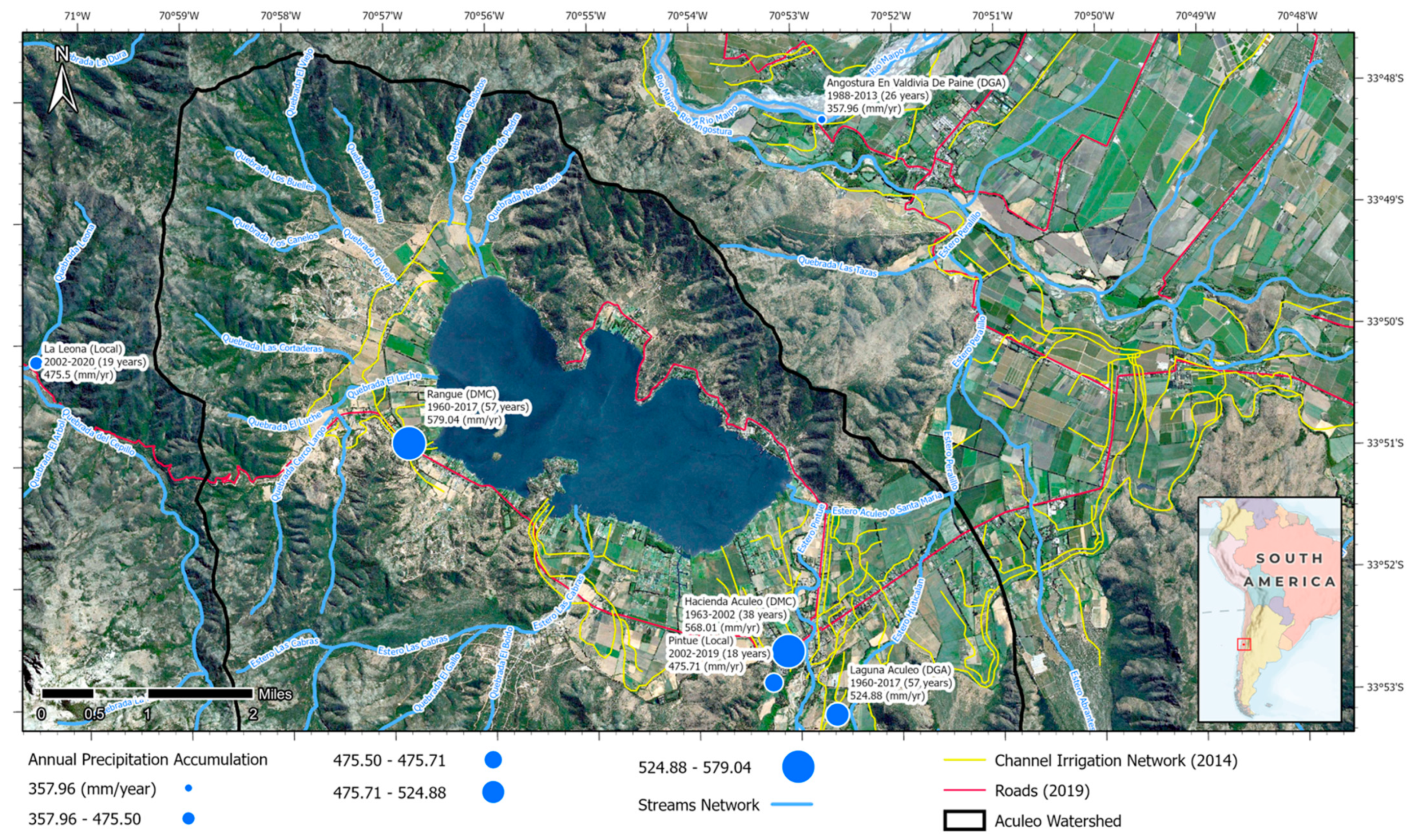
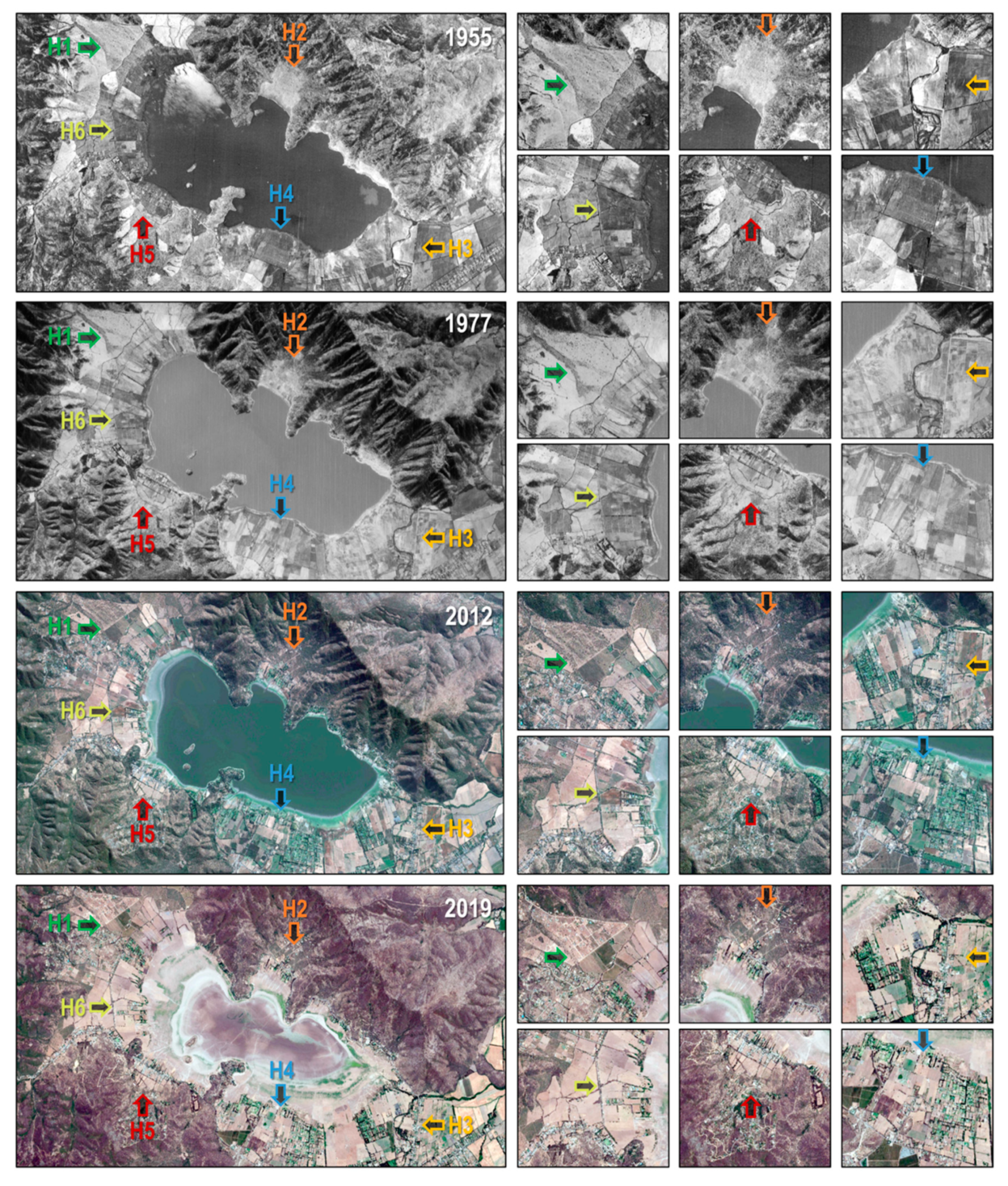
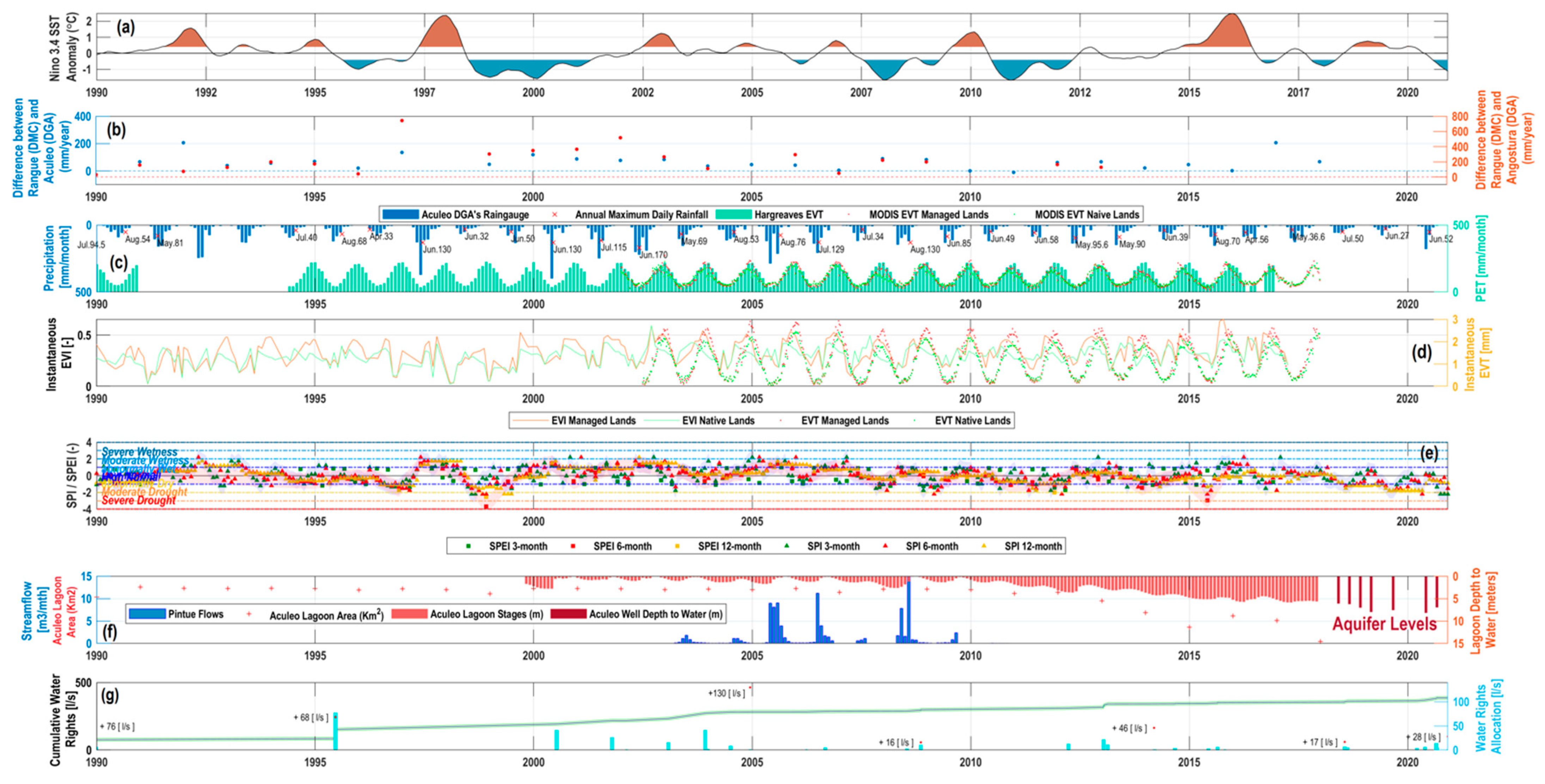


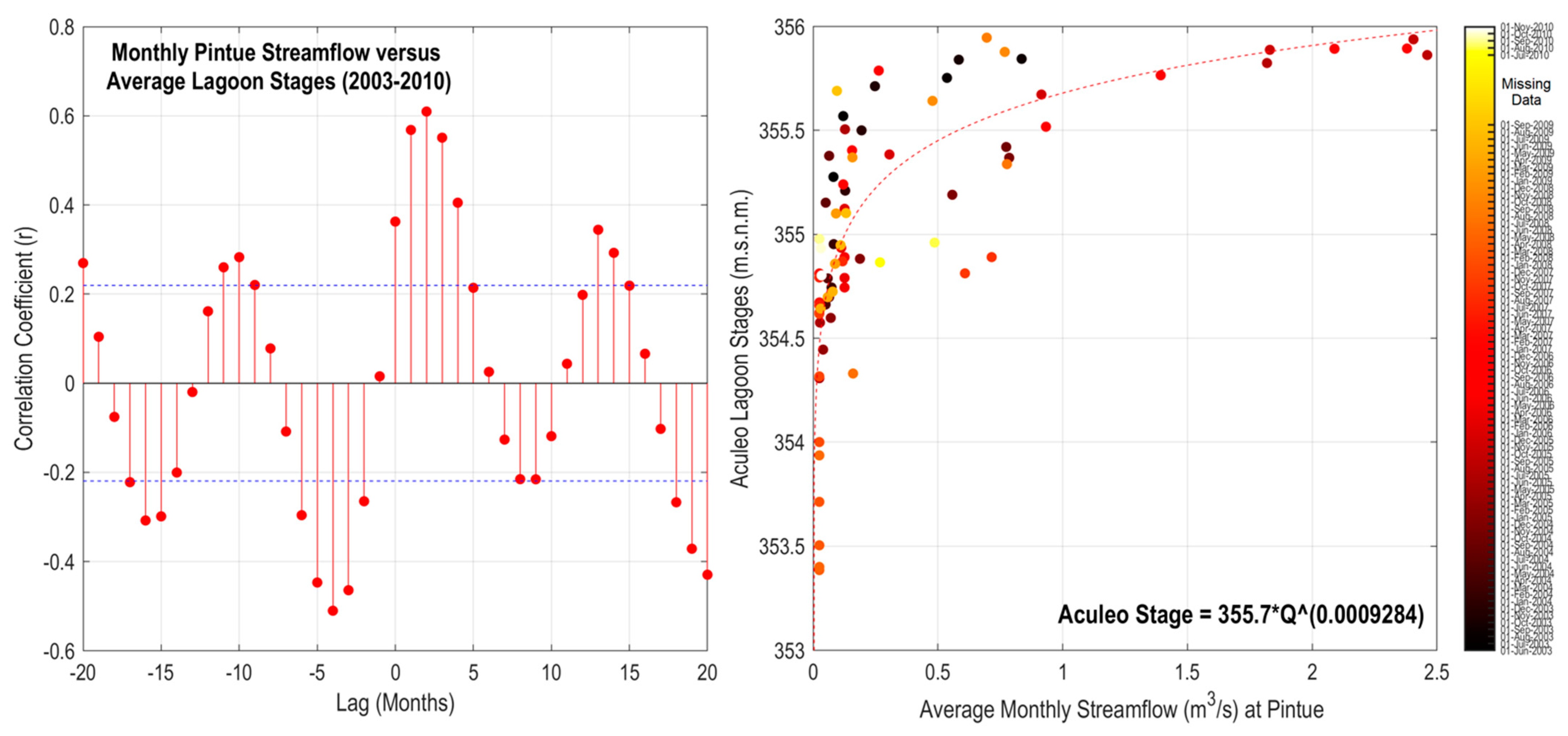

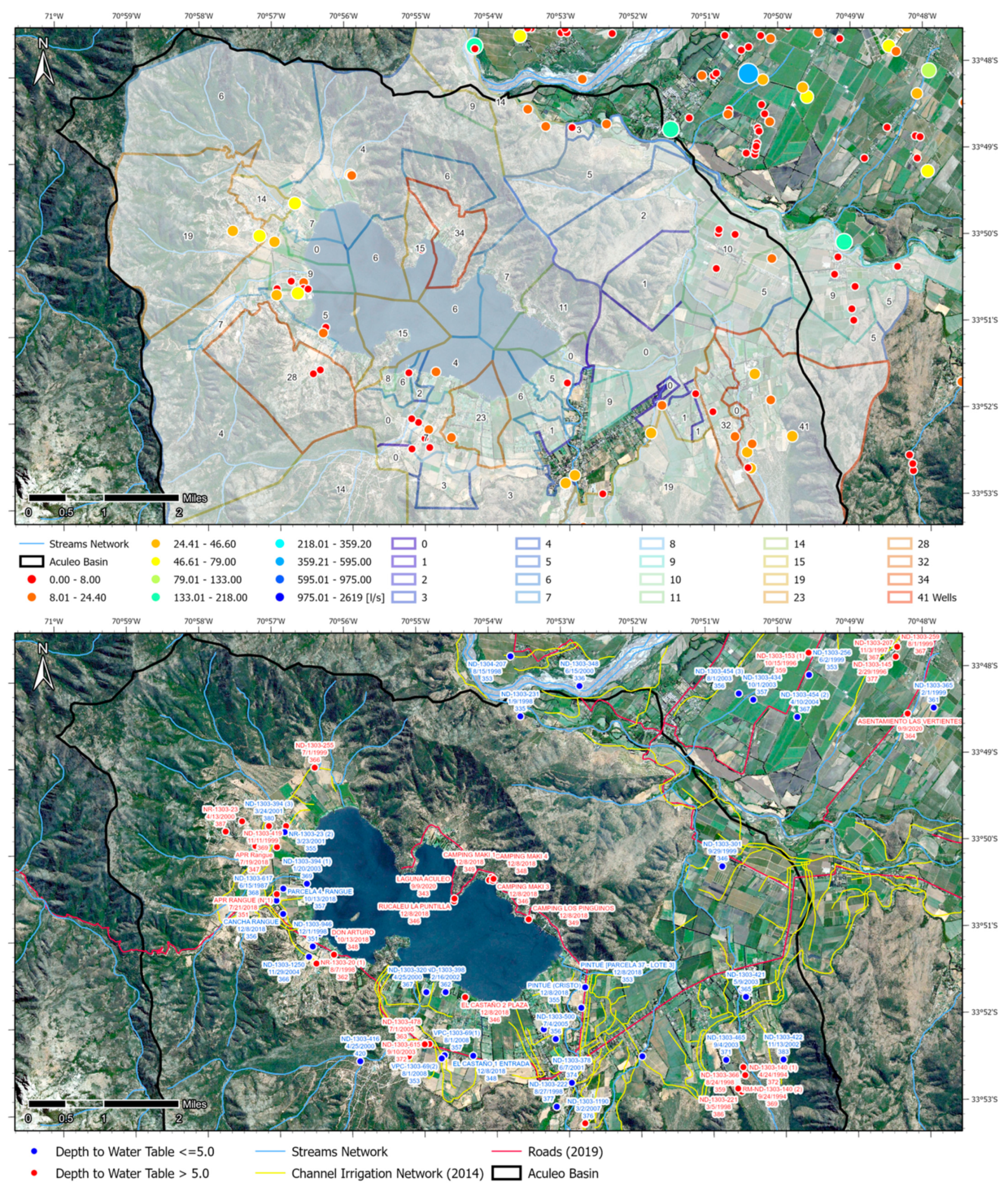
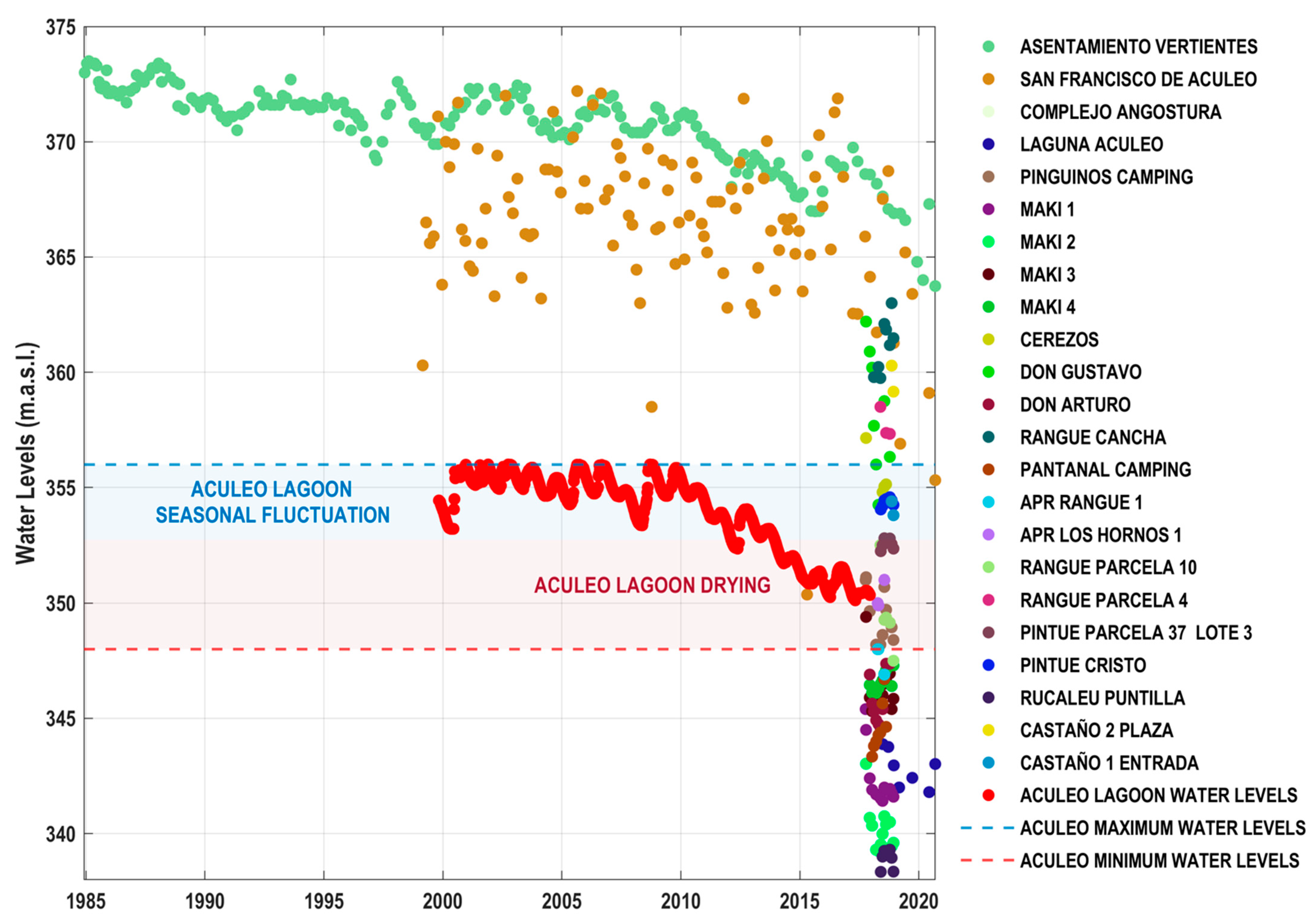
| Institution/Unit | Date | Type | Number | Mater | Groundwater Storage Volume (m3/year) |
|---|---|---|---|---|---|
| DGA/SDT | 01/05/2002 | Technical Report | 133 | Definition of Hydrogeologic Sectors for the Metropolitan Region. Santiago Sur (1896 km2) was defined as one regional aquifer south of Metropolitan Region including Aculeo Watershed and many others. | N/A |
| DGA/SDT | 01/06/2004 | Technical Report | 171 | Definition of aquifer properties and groundwater rights availability for all aquifers (including Santiago Sur ^) defined by Technical Report 133. Results were obtained from Regional Groundwater Modelling. | 630,089,280 ^ |
| DGA/SIT | 01/01/2007 | Technical Report | 119 | It defined maximum allowable withdrawals from Santiago Sur ^ Aquifer. The aquifer was divided into four regional sub-aquifers. El Monte * aquifer (664.1 km2) was defined as the regional aquifer including Aculeo watershed. Results were obtained from Regional Groundwater Modelling. | 97,979,198 * |
| DGA | 09/24/2008 | Resolution | 277 | Declared restriction of groundwater extractions for El Monte Aquifer and established provisional groundwater rights to control extractions. | +12,803,076 P |
| DGA | 02/04/2010 | Exempt Resolution | 248 | Modification of DGA’s Resolution 277. Provisional groundwater rights were increased by about 52%. | +24,494,800 P |
| DGA/DARH | 08/24/2011 | Technical Report | 346 | Re-evaluation of groundwater availability in the Metropolitan Region aquifers, including a re-evaluation of El Monte Aquifer. | N/A |
| DGA | 10/11/2011 | Exempt Resolution | 3121 | Revoked DGA’s Exempt Resolution 248 that had previously established increased provisional groundwater rights in El Monte Aquifer | N/A |
| DGA | 10/13/2011 | Exempt Resolution | 234 | Based on DGA’s Technical Report 346, a new provisional maximum allowable groundwater extraction volume was established. The volume was reduced by about 43%. | +14,117,775 P |
| DGA/DARH | 05/17/2018 | Technical Report | 89 | The hydrogeological delimitation of El Monte Aquifer was updated taking into consideration the conclusions provided by DGA’s technical reports 133 and 119. The sustainable groundwater extraction volume and current demands (up to May 2018) were defined for the new sector named as El Monte Nuevo ** aquifer (206.1 Km2). The report also attributed the reduction in groundwater levels to natural and anthropogenic factors. | 88,518,398 ** |
| DGA | 05/23/2018 | Exempt Resolution | 1430 | Approved the conclusions established in the Technical Report DARH-89. | |
| DGA | 06/22/2018 | Exempt Resolution | 12 | Modification of DGA’s Resolution 277. Declaration of Aculeo Watershed (Aquifer) as area of restriction for new groundwater extractions. This resolution also established new provisional groundwater rights over El Monte Nuevo **. | +1,361,831 **,P |
Publisher’s Note: MDPI stays neutral with regard to jurisdictional claims in published maps and institutional affiliations. |
© 2021 by the authors. Licensee MDPI, Basel, Switzerland. This article is an open access article distributed under the terms and conditions of the Creative Commons Attribution (CC BY) license (https://creativecommons.org/licenses/by/4.0/).
Share and Cite
Valdés-Pineda, R.; Garcia-Chevesich, P.A.; Alaniz, A.J.; Venegas-Quiñones, H.L.; Valdés, J.B.; Pizarro, R. The Impact of a Lack of Government Strategies for Sustainable Water Management and Land Use Planning on the Hydrology of Water Bodies: Lessons Learned from the Disappearance of the Aculeo Lagoon in Central Chile. Sustainability 2022, 14, 413. https://doi.org/10.3390/su14010413
Valdés-Pineda R, Garcia-Chevesich PA, Alaniz AJ, Venegas-Quiñones HL, Valdés JB, Pizarro R. The Impact of a Lack of Government Strategies for Sustainable Water Management and Land Use Planning on the Hydrology of Water Bodies: Lessons Learned from the Disappearance of the Aculeo Lagoon in Central Chile. Sustainability. 2022; 14(1):413. https://doi.org/10.3390/su14010413
Chicago/Turabian StyleValdés-Pineda, Rodrigo, Pablo A. Garcia-Chevesich, Alberto J. Alaniz, Héctor L. Venegas-Quiñones, Juan B. Valdés, and Roberto Pizarro. 2022. "The Impact of a Lack of Government Strategies for Sustainable Water Management and Land Use Planning on the Hydrology of Water Bodies: Lessons Learned from the Disappearance of the Aculeo Lagoon in Central Chile" Sustainability 14, no. 1: 413. https://doi.org/10.3390/su14010413
APA StyleValdés-Pineda, R., Garcia-Chevesich, P. A., Alaniz, A. J., Venegas-Quiñones, H. L., Valdés, J. B., & Pizarro, R. (2022). The Impact of a Lack of Government Strategies for Sustainable Water Management and Land Use Planning on the Hydrology of Water Bodies: Lessons Learned from the Disappearance of the Aculeo Lagoon in Central Chile. Sustainability, 14(1), 413. https://doi.org/10.3390/su14010413








